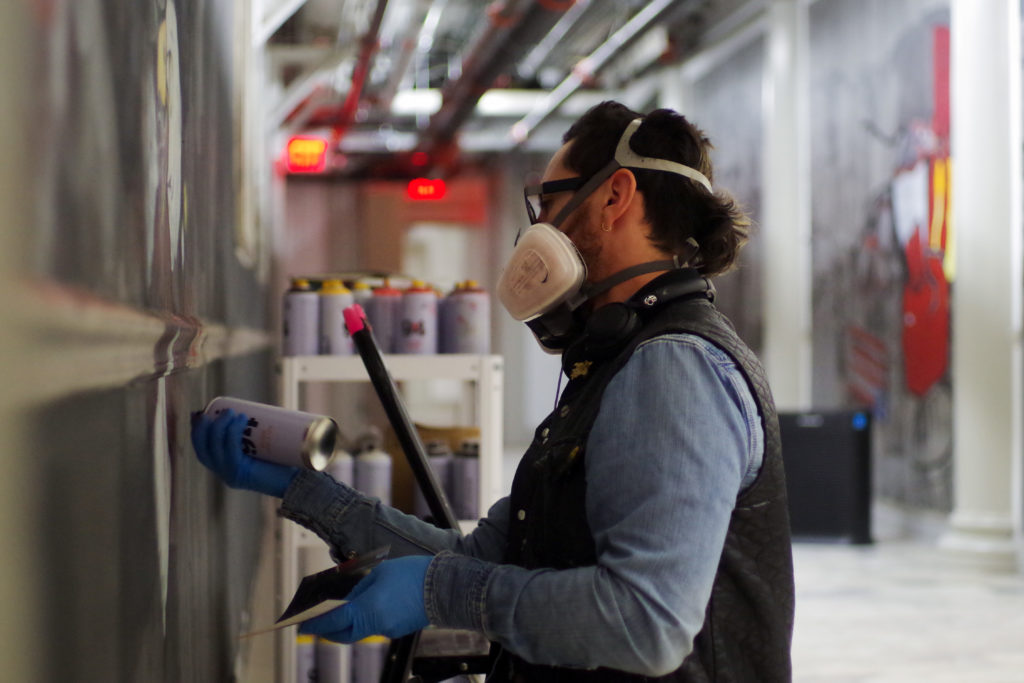A mural in the Corcoran School of the Arts and Design is part of a project that will span 420 million square feet – the same size as the wall President Donald Trump has proposed building along the Southern border.
Artist Joerael Elliott will complete a mural inside the Flagg Building Friday as part of his “Mobilize Walls” series. The spray-painted mural wraps around a majority of the basement walls and showcases the history of the local Piscataway tribe, a Native American group who historically and presently call the District their home.
Parts of the project have been completed in cities like Albuquerque and New York City, all with the goal to “outscale the Trump wall.”
“All the work I’m trying to do is more around transformation and inclusiveness,” he said.
His piece in the Flagg Building is a multicolored mural containing motifs of different birds like the eagle and condor, which are symbolic in uniting Native American groups across North and South America. A skin-tone rainbow that swirls through the work shows the tribes’ diversity, and feathered headpieces, eels and snakes of ceremonial nature are also displayed along the walls.
“To be in collaboration with something outside of your culture, even though they’re a different culture, being an American, it’s something that is here, and it’s something to recognize and honor.” Elliott said.
Words like “land,” and “stolen” are penned on the wall in what he calls “handskrit,” mirroring the graffiti writing one may see around a city.
As an artist without a Native American heritage, Elliott was cautious of misrepresenting Native Americans in his work. He said part of the preparation for his work involved conversations with contemporary members of the Piscataway tribe who still live in the District that could shed light on how to best honor them.
[gwh_image id=”1072503″ credit=”Sabrina Godin | Hatchet Photographer” align=”none” size=”embedded-img”]The spray-painted mural wraps around a majority of the basement walls and showcases the history of the local Piscataway tribe, a Native American group who historically and presently call the District their home.[/gwh_image]
“It wasn’t the Piscataway that were here, the Piscataway still live here,” he said. “That’s part of what I’ve learned through them. A lot of people think, in the history books they’re taught – the people who were once here – but they still exist.”
Sebi Medina-Tayac, a member of the Piscataway Indian Nation, consulted with Elliott on how to properly honor the tribe in a collaborative effort to tell the honest story of his ancestors. From Elliott’s flight into D.C., Medina-Tayac took Elliott to Piscataway Park in Maryland, where 27 hereditary chiefs are buried under one cedar tree, alongside thousands of others buried throughout the park.
“It’s also really a beautiful thing,” Elliott said. “I’m working in the subterranean underground and thinking about the burial grounds.”
Medina-Tayac said that he has seen little to no artistic portrayals of the Piscataway in the District. Landmarks, rivers and roads all borrow their names from Piscataway language, but the community mainly appears as “mythology” or “whispers,” through museum exhibits or sports teams.
“What I appreciate about Joerael’s mural is that it demonstrates the complexity and contemporary presence of our people and our stories,” he said.
Medina-Tayac put Elliott in touch with his mother, who provided oral history that has never been captured in historical accounts of the Piscataway, Medina-Tayac said, meaning the mural is a “dense and complex code” rich with his family’s history. The mural features swaths of Piscataway heritage, including portraits of prominent figures like Turkey Tayac, one of the last leaders buried in Piscataway Park, and references to contemporary activism from the ’70s to the present.
Medina-Tayac said the mural is a “big scrapbook of Piscataway life.”
“Me and my mom will walk through and understand every element of it,” Medina-Tayac said.
Elliott said creating politically-charged art has exposed him to various cultures and he hopes “connecting to the sacred” will rub off on those closest to him.
“Being an activist, or I would call it an activator more than an activist, there’s a spiritual act for me,” Elliott said. “It’s bigger than me just going out and trying to change. It’s trying to change myself as a practice, and changing those who are close to me and always bringing that awareness.”
Elliott will return to campus in the spring to conduct a workshop or host a lecture on graffiti and its history within art, he said. He said he hopes that students will see new images in his artwork that will present new meaning with each pass through the halls.
“If you walk these hallways all the time a year from now, you’ll see something you didn’t see before,” Elliott said. “In my work, what the mural’s about might just hit you one day.”




